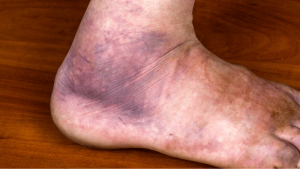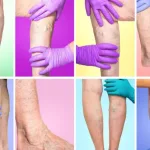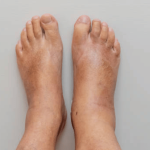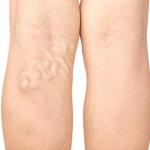
A blood clot in the leg, known as deep vein thrombosis (DVT), is a serious condition in which the blood clot can break loose and travel up to the lungs, leading to a life-threatening pulmonary embolism, which is a blood clot that blocks a pulmonary artery in the lungs.
Vein disease, or chronic venous insufficiency, can increase a patient’s risk of developing a blood clot, also referred to as venous thromboembolism. That’s why recognizing the early symptoms of a blood clot in the leg is important.
However, the signs aren’t always obvious since they can vary from person to person based on the clot’s location, progression, and whether other vein conditions are present. Some people may experience a dull ache or throbbing pain in the calf, while others might notice sharp, sudden discomfort in the thigh. Learn more about what a blood clot in the leg typically feels like and what the warning signs are so you know when to seek medical help.
Can You Feel a Blood Clot in Your Leg?
You may not be able to feel a blood clot in your leg, as some people do not experience symptoms at all. When a clot does cause noticeable symptoms, it may feel like a persistent cramp, a heavy sensation, or an unusual throbbing, especially in the calf or thigh. Unlike muscle soreness or leg cramps, a blood clot typically doesn’t improve with rest, elevation, hydration, or gentle stretching. The discomfort may slowly worsen over time or remain constant.
Common Symptoms of a Blood Clot in the Leg
Having a blood clot in the leg can cause a range of symptoms, although they can resemble common conditions, such as muscle strain or varicose veins. Some of the most common symptoms of a blood clot in the leg include:
- Throbbing pain in one leg, especially when walking or standing
- Swelling in one leg
- Warm skin around the painful or swollen area
- Red or darkened skin over the affected area
- Swollen veins that feel hard or sore to the touch
Early detection of signs of venous thromboembolism is often the best way to prevent potential complications or the need for extensive medical intervention. However, recognizing symptoms of a condition that could lead to a blood clot, such as varicose veins and vein disease, can help prevent the formation of a blood clot altogether. Our symptoms quiz can help determine if you should see a vein specialist for vein issues.
Take Our Symptom Quiz to Learn More
What Do Blood Clots in the Legs Look Like?
Unlike a simple bruise from bumping your leg, a blood clot, especially a Deep Vein Thrombosis (DVT), can be a serious medical concern. The tricky part? Sometimes, the early signs can be subtle or even absent. And when there are visible signs, they can sometimes be confused with common injuries.
Below are images to help you better understand what a blood clot in the legs looks like. Please note that these images are intended for educational purposes only and should not be used as a substitute for a medical evaluation.
It’s important to know that not all blood clots show outward signs. In fact, many deep vein blood clots (like Deep Vein Thrombosis, or DVT) can cause swelling and pain without any visible discoloration.
The Early Stage: Blood Clot Symptoms in the Leg
In the early stages, a blood clot in the leg may cause only mild or subtle symptoms.
Some examples of early-stage blood clot symptoms include mild cramping in the calf, slight warmth or redness in a specific area of the leg or a dull, persistent ache that’s more noticeable when standing or walking.
Varicose veins can be an early warning sign of a potential blood clot. Here’s why: varicose veins are a sign of venous insufficiency, meaning the valves in the veins (usually in the legs) aren’t working correctly, causing blood to pool. This slow-moving blood is one of the key factors that increases the risk of blood clot formation.
Visit a vein specialist if you notice unexplained pain or cramping in the legs that persists.
Signs that a blood clot in your leg is getting worse
As a blood clot in the leg worsens, symptoms can become more noticeable nd harder to ignore. If a blood clot in your leg isn’t treated, it doesn’t simply remain in place. It can grow, worsening the blockage in your vein and dramatically increasing the danger of a pulmonary embolism (PE). This is a life-threatening situation where part of the clot breaks off, travels to your lungs, and cuts off blood flow.
Symptoms that may indicate the blood clot has progressed into pulmonary embolism include:
- Sudden and severe leg pain, especially in the calf
- Difficulty breathing or chest pain
- Coughing up blood
- Pale or bluish skin on the affected leg
- Persistent warmth or redness in the leg
- Rapid heartbeat or dizziness
Seek immediate medical attention if you experience any of these blood clot warning signs.
Do Blood Clots in the Leg Always Cause Pain?
A blood clot in the leg doesn’t always cause pain. Some clots, especially in cases of DVT, can be completely unknown or cause only mild discomfort.
While symptoms like swelling, warmth, redness, and aching are common, they aren’t guaranteed. Many people with DVT have no symptoms at all and may not realize they have a blood clot in the thigh or their leg in general until more serious complications, such as a pulmonary embolism, occur.
How to Check for a Blood Clot in Your Leg
If you’re concerned about a potential blood clot in your leg, there are a few ways you can check for it at home. These signs include:
- Checking your leg size, as swelling typically occurs only in one leg.
- Gently pressing along your leg to detect any tenderness or discomfort.
- Redness, discoloration, or unusual skin tone may indicate inflammation or reduced blood flow.
- Feel if one leg is noticeably warmer than the other.
- Be alert for shortness of breath, chest pain, or coughing up blood, as these may indicate the clot has moved to the lungs.
While you should be aware of the symptoms of a blood clot in the leg, relying on self-diagnosis is risky and often inaccurate. If you think you have a blood clot, seek immediate medical attention.
Schedule a Diagnostic Ultrasound Today
How Is This Different Than A Bruise?
Bruises typically result from an injury, are sore to the touch, and go through a rainbow of colors (blue, green, yellow) as they heal. The pain usually lessens over time..
Blood clots might appear with no obvious injury, cause deep, persistent pain and swelling and the skin discoloration might be more uniform or unusual.
Not sure? Consult with a specialist, especially if you have symptoms or risk factors that increase your likelihood of developing blood clots.
What Increases the Risk of Leg Blood Clots?
While anyone can develop a blood clot in the leg, certain risk factors increase the likelihood of this occurring.
These risk factors include:
| Prolonged sitting or travel | Smoking |
| Recent surgery or hospitalization | Obesity or being overweight |
| Leg injuries | Family or personal history of blood clots |
| Hormonal birth control or hormone replacement therapy | Underlying conditions such as cancer or heart disease |
| Pregnancy and the postpartum period | Varicose veins |
If you fall into one or more of these risk factor categories, it’s important to stay alert for signs of deep vein thrombosis (DVT) because this condition can impair circulation or increase clotting. Consult a vein specialist to better understand your risk and determine whether preventive screening is recommended.
Will a Blood Clot in The Leg Go Away on Its Own?
A blood clot in the leg will not safely go away on its own without medical intervention. While some small clots may dissolve over time, it’s important to get immediate medical attention when you notice symptoms.
It’s possible for a blood clot to be detected during a routine vein screening. While USA Clinics doesn’t treat blood clots, they can treat vein disease if it’s the underlying condition that caused the blood clot. USA Vein Clinics provides non-surgical treatments to alleviate symptoms such as chronic leg pain, swelling, and the appearance of varicose veins.
Don’t Ignore the Signs of a Blood Clot in the Leg
Swelling, pain, warmth, redness, and sudden changes in one leg can all be warning signs of a blood clot in the leg. Even subtle symptoms shouldn’t be ignored.
To prevent blood clots in the leg from developing, see a vein specialist at USA Vein Clinics. Our doctors can evaluate your overall vein health and make personalized treatment recommendations.
Our experts offer minimally invasive, office-based vein treatments for varicose veins, spider veins, restless legs, and other venous conditions. Our treatments can alleviate the painful and uncomfortable symptoms of vein disease, reducing the risk of blood clots and venous ulcers.








